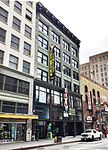Judson-Rives Building
1900s architecture in the United States1924 establishments in California1988 disestablishments in CaliforniaBroadway (Los Angeles)Buildings and structures in Downtown Los Angeles ... and 5 more
Cinemas and movie theaters in Los AngelesCommercial buildings completed in 1906Historic district contributing properties in CaliforniaLos Angeles Historic-Cultural MonumentsNRHP infobox with nocat

Judson-Rives Building, originally the Broadway Central Building, also known as The Judson, is a historic ten story high-rise located at 424 S. Broadway in the Broadway Theater District in the historic core of downtown Los Angeles.
Excerpt from the Wikipedia article Judson-Rives Building (License: CC BY-SA 3.0, Authors, Images).Judson-Rives Building
South Broadway, Los Angeles Downtown
Geographical coordinates (GPS) Address External links Nearby Places Show on map
Geographical coordinates (GPS)
| Latitude | Longitude |
|---|---|
| N 34.0489 ° | E -118.2497 ° |
Address
Perla
South Broadway 400
90013 Los Angeles, Downtown
California, United States
Open on Google Maps









